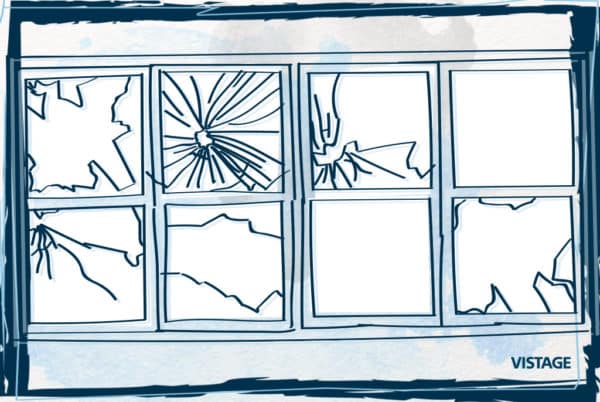Are your windows broken? A leadership study

The organization was showing all the signs of distress: under-performance, low morale, the staff at each other’s throats. As a consultant, I was sent to offer technical assistance to help identify the problems and solve them.
It was a sunny day in May. At the front entrance sat two dead poinsettias. The Christmas foil wrap was faded from the sun. My Sherlock Holmesian powers of deduction told me that someone stuck these Christmas flowers outside to get them out of the office, rather than toss them in the dumpster 25 yards away on other side of the parking lot. And every day for nearly five months, the staff walked past them to go to work, as did customers, investors and stakeholders. You sure can tell a lot about a place by the first impression walking in the door.
The desk of the administrative assistant to the director was the first workspace that a visitor would encounter. She greeted us professionally and hospitably, but I can only surmise she was quite a sentimentalist. Every inch of her work space, both horizontal and vertical, was covered in what could be charitably called tacky clutter. It was a regular yard sale/archeological site that must have been years in the making.
This company’s ‘windows were broken.’
An environment in decay
Broken windows is a criminological theory that suggests that when environments decay in smaller ways, it signals the breakdown of order in larger ways. In simplistic terms, fix the broken windows in an environment as a first step to fighting more serious crime. Rudy Giuliani famously employed this theory as a basis for his crime fighting efforts in New York City in the 1980s, by cleaning up graffiti on the subway. While the theory has some detractors, mostly those who argue about overreach rather than disagreement, I am convinced it has merit in all organizations.
In this case, the company’s leadership was eager for assistance but clueless about the state of the broken windows. The larger problems were so overwhelming that they overshadowed that which seemed to be of much lesser importance, like dead plants on the doorstep or a reception area that was a scene from Hoarders. Why sweat the small stuff when there were serious issues to be addressed? Leadership urgently needed to address the failure to comply with guidance and procedures, the atrocious staff infighting and morale so low it could barely be measured.
Small, immediate solutions
Our suggestion that a quick win might be to clean up the obvious broken windows met with resistance. This leader was more willing to own that there were BIG serious problems needing BIG serious answers provided by an outside consultant than own the small, immediate solutions. Insisting the staff maintain professional-looking work spaces might have been a positive first step to them effectively performing their jobs. And yes, there may be some employee resistance to the efforts to clean and unclutter the office environs.What a perfect opportunity for the leader to do what leaders are supposed to do, rather than cave to pressure or avoid the obvious mess.
On reflection, our ultimate effectiveness as outsiders helping this organization is debatable. The leader was fired soon after our consultation, but the lessons remain. If you walk past something every day, you might not recognize how shabby it has become. That applies to organizations, relationships, cities and more. The small stuff matters and provides a window into the quality of the leader inside.

